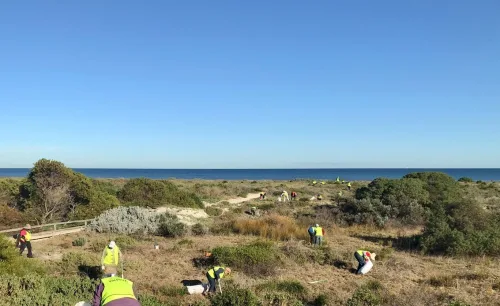Marine lovers from the Semaphore Largs Dunes Group have been working hard to care for their local environment. We sat down with Bernadette McDonnell and Sandra Dann to find out how a Grassroots Grant supported rehabilitation of Semaphore’s coastline.
Extreme weather events – and their increasing magnitude and frequency – have had a destabilising impact on the dunes of Semaphore and Largs Bay, leaving the environment exposed.
Volunteers are carefully rehabilitating this area to minimise the impact of severe weather events, and protect habitat which supports marine plants and wildlife.
Bernadette McDonnell and Sandra Dann of the Semaphore Largs Dunes Group have been leading a charge to revitalise the dunes, and have been engaging the local community in the process. Find out how a Grassroots Grant is helping to enable this important project.

Students were given the opportunity to rehabilitate the dunes
Why is this grant project important?
Sand dunes provide an important buffer in extreme weather events, protecting coastal environments from wind and tides. But over time, dunes can be eroded. Bernadette McDonnell explains how a Grassroots Grant is helping to rehabilitate the dunes.
“The Coastal Sand Dune Rehabilitation Project monitors the health of sand dunes, removes invasive animal and plant species, and regenerates local native plants,” Bernadette said.
“We have been focusing particularly on planting natives, as these can help stabilise the dunes. This means the dunes are more resilient when extreme weather events occur.”
Through planting natives and removing pest species, volunteers with the Semaphore Largs Dune Group are helping to protect coastal environments.

Students were given the opportunity to rehabilitate the dunes
How did the grassroots grant help?
Thanks to a Grassroots Grant, 4 coastal groups along the Le Fevre Peninsula were able to link up with the local community, local schools and the City of Port Adelaide Enfield to care for the coastal environment. This included the Semaphore Largs Dunes Group, Taperoo Dunes Group, Friends of North Haven Dunes, and the Port Adelaide Resident’s Environmental Protection Group (PAREPG). Sandra Dann explains how the grant supported collaboration on the rehabilitation project.
“The grant assisted in staging several workshops. We had volunteers work with local primary school students to increase their knowledge and awareness of the coastal environment,” Sandra said.
“Young people were taught principles of bushcare, including seed collection, propagation, and planting indigenous plants.
“And we engaged local schools in an opportunity to ‘adopt’ a dune, so that the area would have long-term, sustainable care through regular visits and work.
“The grant was also significant as it provided the chance to engage contractors on weed removal, which has ultimately helped new local natives, planted by our volunteers and school groups, become well established in the dunes.”
The Semaphore Largs Dunes Group also created a ‘Biolink’, a wildlife corridor that connects pockets of native vegetation to support animals in moving safely along the coast.
Over 6,000 native seedlings were planted, including reintroducing and propagating local indigenous species that had almost disappeared from the area.

A community weeding day at Semaphore
Why is this grant project important?
While the removal of pest species and engagement of volunteers to plant natives was hugely beneficial in protecting this area of the coast, the project has also contributed to community wellbeing.
The Semaphore Largs Dunes Group involved the local community in weeding days, seed collection, propagation and planting days. Sandra Dann explains how people united to reach a positive result for their coastal backyard.
“People living locally came together, worked collaboratively, and contributed to sustainability for their local environment,” Sandra said.
“There is now a heightened awareness of the importance of our coast. The local community has taken pride in increasing their knowledge and responsibility for the coast.
“This awareness in turn has encouraged many people to be involved in showcasing the local dunes at various times throughout the year - for example, Nature Festival events and autumn and spring walks.”
Do you have any words of advice for future grant applicants?
The Semaphore Largs Dunes Group encouraged future grant recipients to work toward engaging lots of people in projects.
“We would encourage grantees to work with the local Green Adelaide representative, the local council and engage the community as much as possible,” Sandra said.
“It is the combination of knowledge sharing and coming together which can make a project go from a one-off idea to a sustainable legacy.”